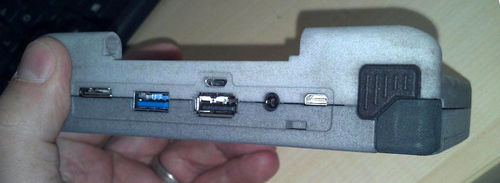USB
The Pyra has four USB ports, as detailed below.
For our purposes:
- "USB2" means "capable of Low, Full and High-speed"
- "USB3" means "capable of low, full, high and super-speed"
- "OTG" means capable of operating in either host- or slave-mode.
Full-size USB2 Port
This is a straightforward USB port as found on many desktop PCs. I can be used for keyboards, mice, USB memory sticks, network adaptors and many other things (subject to driver support)
Hardware:
- Assmann AU-Y1006-2-R - USB TYPE-A USB 2.0 Receptacle Connector 4 Position Surface Mount, Right Angle
- IP4220CZ6F - Dual USB 2.0 integrated ESD protection
Full-size USB2 Port with eSATA
This can be used as a simple USB2 port as above. Although this uses a blue Connector designed for USB3 Ports, it is not capable of USB3 (with the current CPU-Board). The additional pins are used for (e-)SATA Lanes for to an Adapter.
Hardware:
- Molex 48393-0003 - USB 3.0 Female Type A Connector
- USB 2.0 data pins connect to "HOST1-D" pins of the CPU module
- USB 3.0 data pins connect to "SATA-RX" and "SATA-TX" pins of the CPU module
- TPD4EUSB30 - 4-Channel Transient Voltage and ESD Protection for Super-SpeedUSB 3.0 Interface used on eSATA lines
See Storage for more details.
Micro-USB3 OTG Port
This can be used much like the full-size USB2 ports, but at higher speeds and with the obvious requirement for a passive adaptor when using most peripherals. It can also be used to charge the Pyra (either from another computer, or a mains adaptor) and to operate as a USB slave. The Pandora has software allowing it to operate as a USB mouse, joystick, keyboard or SD-card reader in slave mode. It is expected that similar software will be available for the Pyra.
Hardware:
- BossConn USB3-MICABF-CO02 - USB 3.0 Micro AB Female Connector
- TPD4EUSB30 - 4-Channel Transient Voltage and ESD Protection for Super-SpeedUSB 3.0 Interface
- IP4220CZ6,125 - Dual USB 2.0 integrated ESD protection
- DLP11TB800UL2L - 2 x Common Mode Chokes / Filters 0504 80ohm EMI Suppression Filter
- ACM2012-900-2P-T001 - Common Mode Choke / Filter 50V 200mA 680ohms AEC-Q200
- FPF3040UCX - 18V-RatedDual Input Single OutputPower-Source-Selector Switch
Serial-via-micro-USB2 Port
This is not a general-purpose USB port (as a result of limitations of the SOC) but can be used in two ways:
- Charging the Pyra while the primary microUSB3 port is in host mode.
- Monitoring the Pyra using another computer (Serial output from the Pyra's processor, via a built-in Serial-USB translator, with the Pyra as USB slave)
Hardware:
- Molex 105017-001 - Micro-USB B Receptacle, Bottom Mount, Surface Mount, with Solder Tabs
- FT232RQ - USB to serial UART interface
- FPF3040UCX - 18V-Rated Dual Input Single Output Power-Source-Selector Switch
- Chooses where to connect USB "VBUS" power lines when "EN-OTG" is set or not.
- TPS22963CYZPT - Digital power switch to send power from "VSYS" to USB FPG3040UCX when "EN-OTG" is set
Charging
The Pyra will charge from a standard microUSB2 cable, connected to a standard 5V USB2+ charge brick. This can either be plugged into the USB2 section of the Micro-USB3 port, or the serial debug and charge Micro-USB2 port.
Hardware:
- BQ24297RGER - I2C (addr 0x6b) Controlled 3A Single Cell USB Charger With Narrow VDC PowerPath Management and Adjustable Voltage USB OTG
- Looks after "VBUS", "VBATT", "VSYS", and the USB "OTG" voltages.
- Provides a "CHG-STAT" charging status used to make "LED-PWR" red.
- Monitors the "BATTEMP" battery middle pin.
- Sends "CHG-INT" 256-μs pulses to the CPU module to report charger device status and fault.
- TLV70233DBVR - LDO Voltage Regulator, drops VSYS down to 3V3, but only when CPU Module supplies "1V8" to the LDO's enable input
- INA231YFFT - High or Low-Side Measurement, Bidirectional Current and Power Monitor With 1.8-V I2C (addr 0x4x) interface
- TPS22963CYZPT - 5.5V, 3A, 13mΩ On-Resistance Load Switch
- To control "VMODEM" from "EN-MODEM" signal
Sample of potentially official charger
